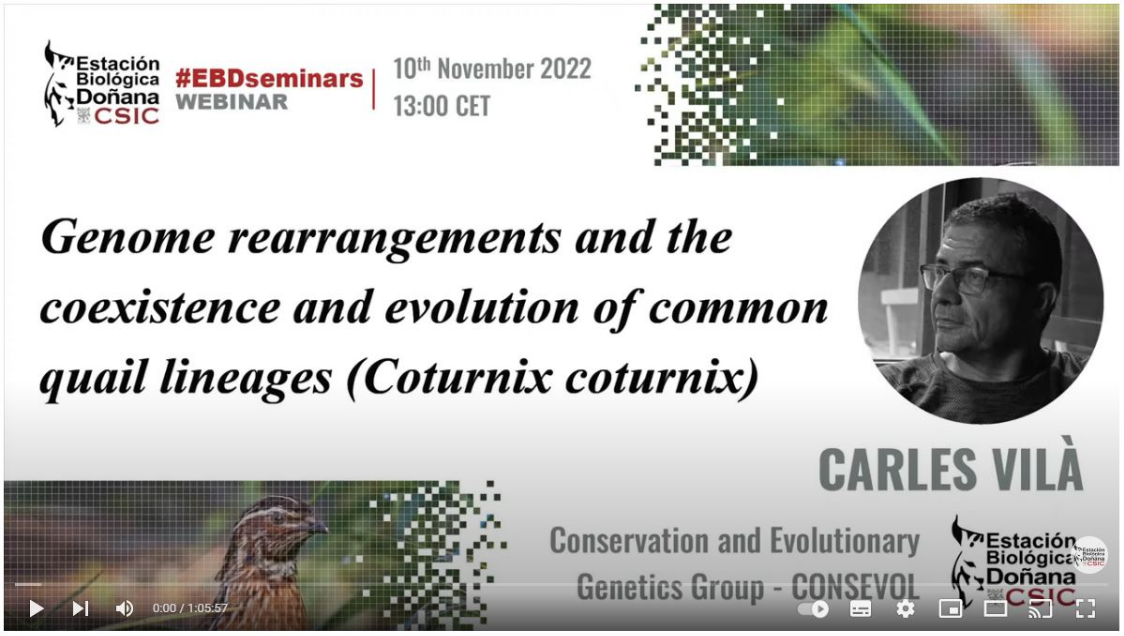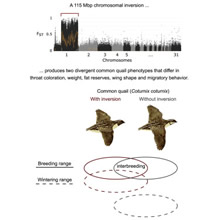Conservation and Evolutionary Genetics Group |
||||||||||
| HOME | PEOPLE | PROJECTS | PUBLICATIONS | RESOURCES | COURSES | JOB VACANCIES | NETWORKS | OUTREACH | CONTACT | |
The role of chromosomal inversions in the evolution of common quail (Coturnix coturnix) populations |
Funded projects |
 |
Chromosomal inversions as a mechanism for sympatric differentiation in quails, PID2019-108163GB-I00
|
Chromosomal inversions result in the linkage of genes through reduced recombination, producing “supergenes”. We have found a very large inversion in some common quails from the south of the Iberian Peninsula, Morocco and archipelagos in the eastern Atlantic. This inversion includes more than 1200 genes and is associated with darker throat coloration, slightly bigger size, rounded wings less suitable suitable for long flight, and reduced migration. The inversion could also be responsible for the uniqueness of Canary Island quails, assumed to be a different subspecies, but quails in other Atlantic archipelagos may be the result of evolution in isolation. However, little is known about the mechanisms of coexistence of quails with and without the inversion and with different migratory patterns inside the same populations |
 |
Some results

Photo by Carles Vilà. All rights reserved. |
A massive genome inversion drives coexistence of divergent morphs in common quails Our results show that one very large chromosomal inversion is affecting the genome of common quails in the southwest of the Iberian Peninsula, Macaronesia and Northern Africa, and that this is associated with differences in pigmentation, size and wing shape. It is also leading differences in migratory behaviour. |
|
Evolutionary history of an island endemic, the Azorean common quail Oceanic islands are characterized by conditions that favour diversification into endemic
lineages that can be very different from their mainland counterparts. This can
be the result of fast phenotypic divergence due to drift or the result of slower adaptation
to local conditions. This uniqueness can obscure their evolutionary history.
We used morphological, stable isotope, genetic and genomic data to characterize
common quails in the Azores archipelago and assess the divergence
from neighbouring common quail populations.
|
 |
|
Evolutionary history of an island endemic, the Azorean common quail |
|
More inversions in the common quail genome Large inversions shape diversification and genome evolution in common quails |
People
Carles Vilà is leading this project, which is a collaborative effort with the coPI José Domingo Rodríguez Teijeiro, from the University of Barcelona (UB), and the other members of the research team.
Elif Çeltik, Celia Vinagre-Izquierdo and Irene Jiménez are currently working in this project as PhD students and Ines Sanchez-Donoso as a post-doc/research assistant.
 Elif Çeltik |
 Celia Vinagre-Izquierdo |
 Irene Jiménez |
||
 Carles Vilà |
 José Domingo Rodríguez Teijeiro |
 Ines Sanchez-Donoso |
Some of our collaborators in this project are:
Outreach
Check for news about this project in Bluesky ![]() and Mastodon
and Mastodon ![]()
Watch Carles Vilà talking about the EVOLQUAIL project and our latests findings.
 |
|
La sorprendente estructura poblacional de la codorniz
|
Evolutionary genetics: Inversions — Do not quail but go big! Dispatch paper in Current Biology by Ishigohoka J & Liedvogel M. January 2022
|
Illustration by Corinna Langebrake |
Chromosomal rearrangement linked to less mobile quail The Scientist. December 2021
|
|
Un supergen limita la migración en las codornices Estación Biológica de Doñana website. November 2021
|
 |
|
© 2025 CONSEVOL |











